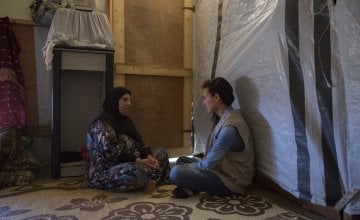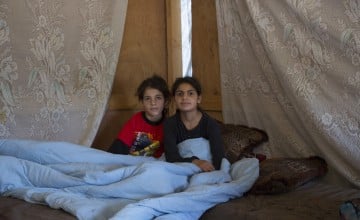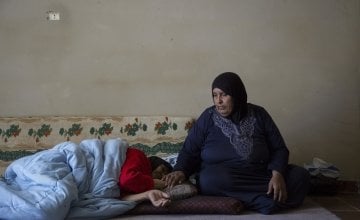
Read our 2024 annual report

Knowledge Hub
As the conflict enters its tenth year in March, here are five things to know about the impact of the Syrian crisis in 2020.
Since early 2011, the Syrian conflict has resulted in enormous suffering for millions of people. It has displaced an estimated 12 million Syrians, nearly half the estimated pre-war population. Of these, 5.4 million are living as refugees in neighbouring countries — namely Turkey (3.6 million), Lebanon (nearly 1.5 million), and Jordan (over 650,000).
Displaced Syrians face challenges and trauma
As the conflict approaches its tenth year, families have been forced to flee their homes and become displaced to new locations as many as nine times or more. While one round of displacement is very traumatizing, multiple displacements present an unimaginable psychological burden for each person, as they adjust to living in a new and unfamiliar area.
Once people are forced to leave their own homes, their social structure and the nourishing environments of their home and community, they become extremely vulnerable and often suffer acutely as they are regularly deprived of food, water, health care and other essentials. This suffering increases with each displacement, whether it is to camps, informal settlements or living with host communities. These often offer less safety and dignity, resulting in greater hardship.
Over the years of conflict, and as the areas of attack changed, Syrians usually fled with the bare essentials that they could carry. Sudden and violent onset of violence has deeply disrupted the psychosocial well-being of children and adults.
Many of those forced to flee lose items that confirm their identity. In the continued search for a safe place to live, mothers, fathers and children in Syria flee without state identification, causing issues to move within the country as there are checkpoints across the country. It also poses challenges for those seeking refuge in neighbouring countries.
As this is a protracted conflict resulting in a complex emergency, the needs in Syria of displaced people who are very vulnerable continue to increase.

Civilians are suffering the most
By many accounts of Syrians still living in the country, the violence is not confined to bombing, missile attacks, and the destruction of cities like Idlib, Aleppo, and Raqqa. Rather, it has seeped into every aspect of Syrian life. Before the conflict, Syrians lived in relative harmony among their communities. However, since 2013, (when we first began working in Syria), many civilians have told us that they don’t feel safe or secure in any environment — including their own homes as the consequences of the conflict has impacted every community. Personal security is no longer taken for granted and is an alien feeling for millions of Syrian people.
With the conflict soon to enter its tenth year, available resources in Syria will continue to diminish, and the ability of enjoy a safe and decent livelihood is diminishing. The deteriorating economic situation is causing household assets to further be strained. In the latest Humanitarian Needs Overview March 2019 report by the United Nations, it indicates that 15.5 million Syrians are still living in need of clean water, sanitation, and hygiene support.
Within the 15.5 million people living in Syria, there are 13.2 million (over 70% of whom are female) in need of health support and protection assistance including safe and dignified shelter (4.7 million). Nine million Syrians are dependent on food assistance, as well as livelihoods support, to earn an income.
Conflict is gendered
The war in Syria is effecting men, women, boys and girls in starkly different ways that often reinforce existing gender inequalities - especially among extremely vulnerable people. Throughout the conflict, Syrian men and women have often had to take up negative coping mechanisms to survive and support their families.
Gender-based violence (GBV), domestic violence, sexual harassment and sexual violence have increased across the country, with many women reporting that their husbands are quicker to resort to violence, as the external conflict takes an increasing psychosocial toll within the home. The conflict has led to a vast amount of single female-headed households without a primary breadwinner.
Negative coping mechanisms have increased as a result of depleted resources and eroded social cohesion. Women and children are disproportionately affected by this with rising levels of girls’ early marriage, child labour and youth recruitment into armed groups. Child labour has increased with boys and girls entering into the workforce to help the family survive.
Men also face greater risk of arrest, detention, harassment from the security services, recruitment into armed groups, disappearance and death.
The elderly and those with disabilities, particularly those with limited family support, have a wide range of unmet needs in displacement situations with sporadic service delivery.
This has led to changes in household dynamic, social order and community structure as different members in society take up untraditional roles in society.

Risk of a ‘lost generation’
The war has directly affected children’s access to education in Syria. The March 2019 report by UNICEF suggests that 40% of Syria’s school infrastructure has been destroyed in the conflict, creating huge gaps in the provision of education and adverse protection risks. Currently, there are 2.1 million Syrian children out of school, with some being out of education for up to six years.
Before the war, Syria had a high attendance rate for primary school - 97% - but education had to stop due to the conflict as it was/is unsafe for children to go to school. This has limited their ability to participate in education and limits their future ability to live full and creative lives. The longer the conflict continues, the greater the risk that an entire generation of young Syrians will become “lost” due to a lack of access to quality education in a safe way.
Weather is a threat multiplier
Despite its high temperatures of up to 44 degrees Celcius in the summer months, Syria has bitterly cold winters. Temperatures can drop below freezing between the months of November and February. This is also true of the surrounding areas that host many Syrian refugees — winter storms in Lebanon last year affected many people living in the informal refugee settlements. For all Syrians, regardless of where they are, who are living in poor housing, shelter, warmth, and hot nutritional meals continue to be a priority.
Weather events have a ripple effect on other areas of need: serious flooding in early 2019 in Syria damaged crops and affected food security, leaving 21,000 acres of land underwater and displacing thousands of families.

Concern in Syria
Concern Worldwide has been responding to the crisis in Syria since 2013. Our teams on the ground are providing food and non-food items, including plastic sheeting, floor mats, solar lights, and blankets. Maintaining a very rapid emergency response, our turnaround time is generally two days for assessment and distribution. Areas of focus include:
- Food security and livelihoods support has been delivered in the form of cash or voucher support to over 337,000 beneficiaries
- Protection, including the delivery of child-friendly spaces, self-healing and learning spaces, and gender-based violence prevention to approximately 1,000 beneficiaries
- Education access for children in non-formal education centres benefitted over 15,000 beneficiaries
- Water, sanitation, and hygiene assistance, including activities such as hygiene kits, rehabilitating water systems, emergency water trucking, hygiene promotion and vector control benefiting over 900,000 beneficiaries
According to a 2016 estimate by the United Nations Economic and Social Commission for Western Asia (ESCWA), 83% of the Syrian population are now living below the poverty line. Coping mechanisms are severely depleted and basics like food, education, and shelter becoming harder and harder to access.
Your tax-deductible contribution to Concern can help us provide valuable support to those who need it most.
Support our work
We're doing everything we can to make life easier for the millions of Syrian people who have been forced to flee from conflict - but we need your help.
Other ways to help
Corporate support
Is your company interested in working together for a common cause?
Fundraise for Concern
From mountain trekking to marathon running, cake sales to table quizzes, there are lots of ways you can support our work.
Buy a gift
With an extensive range of alternative gifts, we have something to suit everybody.
Leave a gift in your will
Leave the world a better place with a life-changing legacy.
Volunteer with Concern
The lots of ways to get involved with our work as a volunteer
School fundraising
Without the generous support from schools, we wouldn't be able to do the work that we do.




